The Flights and Plights of Milkweed Seeds
By Jim Moerschel
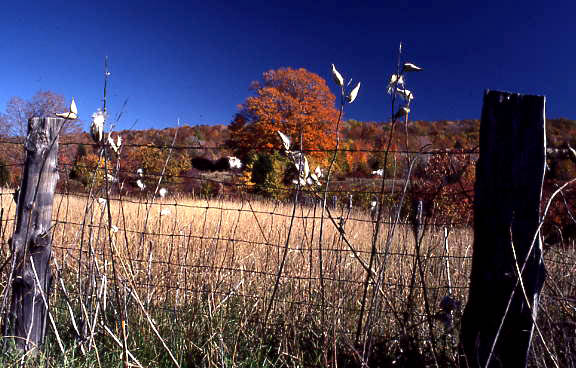
The heavy morning dew began to penetrate my sweater as I lay in the tall
grass of the open field. Concentrating my macro lens on a tiny milkweed
seed,
I saw it had become entangled on a thin stalk of wild grass.
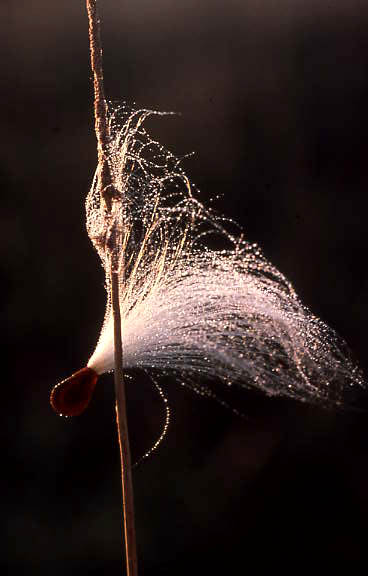
The silky fibers and the seed were so perfectly balanced that each passing
breeze made it pivot completely around the stalk. Here I was, observing
natures miniature weathervane at work. After several minutes, the gentle
breeze subsided and I made my photograph.
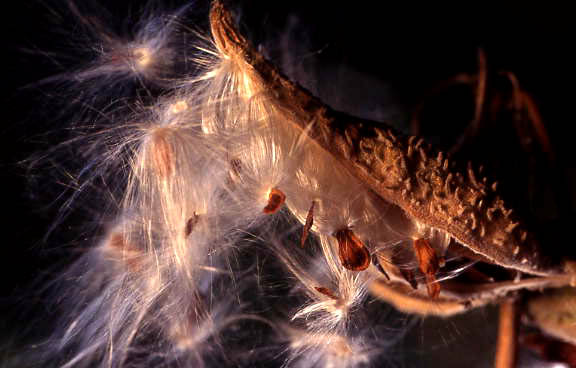
Milkweed (Asclepias), named after the legendary Greek physician, is very
common along roadways and open fields. It derives its name from the abundant
milky fluid contained in the stalky branches.
Nature has provided the milkweed with a fascinating method of seed dispersal.
The pods or follicles are arranged in pairs and hold a large number of
flat, oval
seeds tufted with many silky hairs. In autumn, each follicle will burst
open along
one side and as the wind blows, the hairs are pulled from their chamber
and they
float through the air on a perilous journey.
I’ve been photographing milkweed for many years and my equipment
has changed a bit during this time, but not drastically. As usual, I always
carry 2 camera bodies in case one breaks down during the shoot. For many
years I used
a 55mm Nikkor macro lens, and a 105mm Nikkor for most of the images. I
have always used a tripod on these photos and when it was necessary to
get down real low
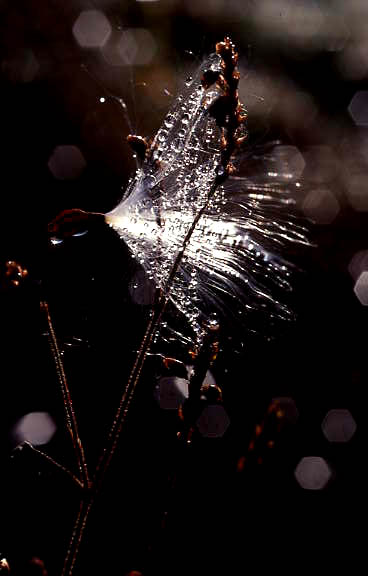
in the grass for a single seed photo, I have employed the Bogen Super
Clamp on
one leg of the tripod to support the camera.
A set of extension tubes is great to help increase the magnification to
desired
image size. These come in sets of 3 tubes, which can be coupled together
or used
separately depending on the photographers needs.
In recent years I have added new generation cameras with auto focus, matrix
metering and other features and have added newer macro lenses. My choice
of film
remains slides and the ISO can be whatever the photographer feels comfortable
with.
When creating any image, lighting the subject is the critical factor that
will
determine how dramatic and powerful the final photo will be. For these
outdoor
“still lifes” I bring along two reflectors and one inexpensive
mirror ( camping type
or handheld type found in department store). With these tools, I can use
the early
morning sun as the main source of light and arrange the reflectors and
mirror to
create any type of lighting on the seed pods.
When photographing the solid, opaque pods and the silky, translucent seed
para-sails I generally placed my tripod facing the early morning sun.
The low angled rays would back light the silky hairs making them radiate.
Then I was able
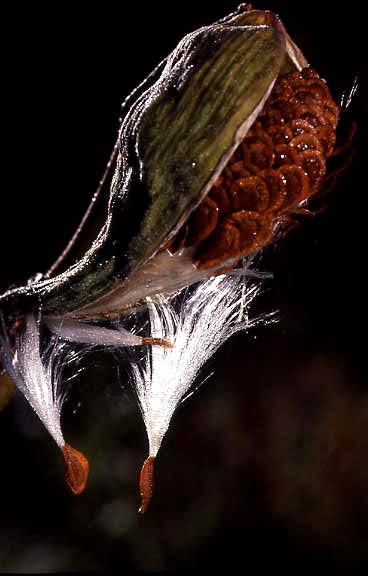
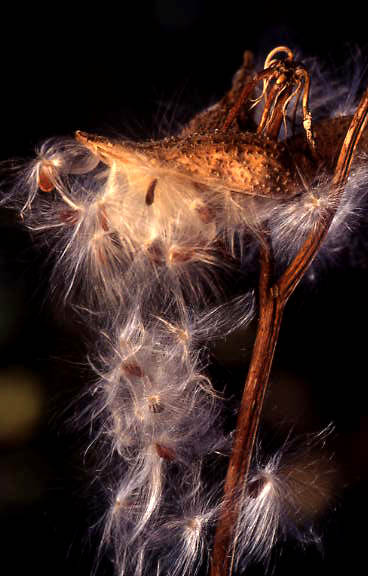
to place the reflectors on the near side of the opaque pod and bounce
the light to
show detail. The mirror, being able to shine a more intense beam of light
than the
reflectors was used as a type of “spotlight” in many of these
images. With these
tools, I am able to create an outdoor studio in any field, swamp or woodland.
Colonies of milkweed are quite large and this means that there are many
choices
of subjects. The trick is to find the ones that are most photogenic. This
takes some
close up searching. Once a good scene is discovered then it’s a
matter of placing the
camera at the proper angle of view and setting up the mirror and reflectors
to best
illuminate it.
One day I came upon a cluster of pods with most of their seeds in the
process of “riding” the wind. It was a beautiful macro scene,
but I knew it wouldn’t last long.
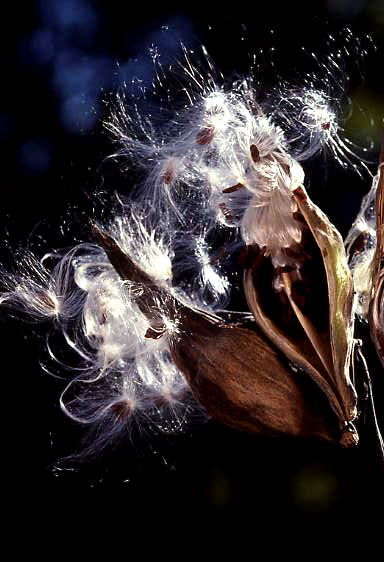
That’s one of the challenges of this type of image making. Nature
waits for no one.
The breeze became stronger and the seeds were flying everywhere. I positioned
the tripod so that the camera faced the most photogenic side of the pod
and I tightened up the composition using the 105mm macro lens. The background
was not a consideration on this shot. Most of the seeds silky hairs were
back-lit by the
radiating low angled sun. The next step was to position the mirror so
that the inner
portion of the chamber and seeds would be well lit to show lots of detail.
The breeze
pulled several seeds out at the right time as I hit the shutter button
and the final image shows seed dispersal in action.
One of the wonderful points about photographing nature scenes is that
the
photographer can come back over and over and shoot the same subject, but
they
will discover that nature provides an infinite number of varying conditions
that
completely changes what the image looks like.
On several days, I would walk into the field at daybreak and discover
that the
pods were all encased in frost. So, before the sun could rise over the
hillside I would
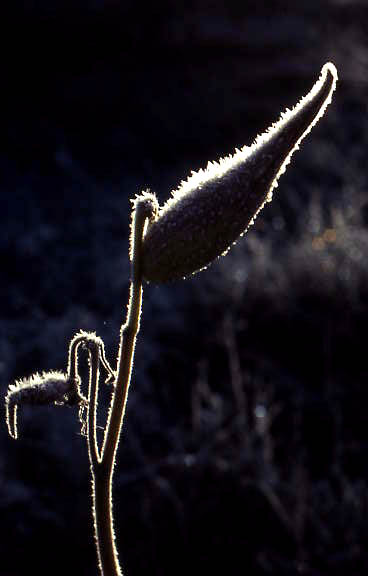
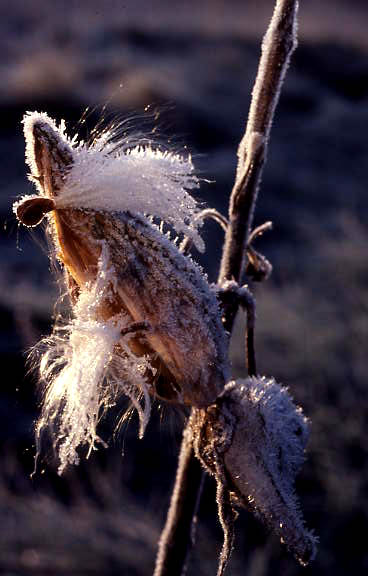
take this opportunity to make images of “frost pods.” Once
again, it was a matter
to find those that were photogenic and then set up as quickly as possible
before the
sun would rise and melt the frost.
On another day I discovered a pod that was just exploding with seeds as
the breeze was very strong. The sun was quite high in the sky and I decided
to create
a silhouette image. The tripod was set so that the sun was shining right
through the
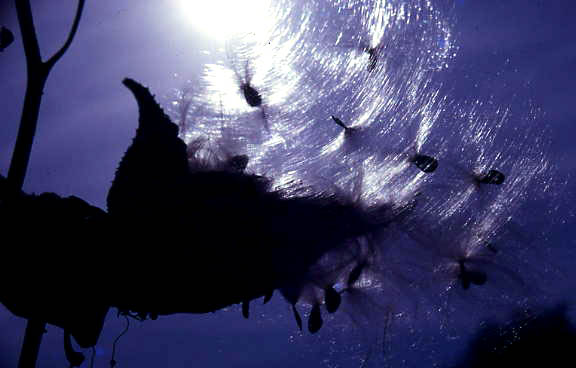
silky fibers. Because the seeds were moving out of the pod so quickly,
I needed a fast shutter speed to freeze the action. Because the lens was
aimed upward and into the direct sunlight I was able to use 1/1000th of
a second as my shutter speed. The lens was set at 5.6 for the first shot.
Then I made a few more exposures “bracketing” by closing down
to f8 , f11 and so on. No reflector was used on the near side which produced
a powerful silhouette. The final image shows the silky
hairs to appear as if they are spun glass, reminiscent of angel hair used
on a
Christmas tree. My title for this shot is “Natures Angel Hair.”
Once the seeds leave the pods they can fly for several miles or only a
few feet.
Many of them never germinate as they fail to find a suitable habitat to
begin new life. It is great fun to walk all over a field searching for
the tiny silky parachutes
as they are everywhere. I would find some ensnared in spider webs, sitting
on top
of purple asters, stuck to twigs and leaves, floating in a brook, the
situations
were endless and many made great photos.
One afternoon I discovered two seeds stuck to the colorful leaves of Staghorn
Sumac. As I set the tripod up, I studied the scene carefully. The two
seeds dangled
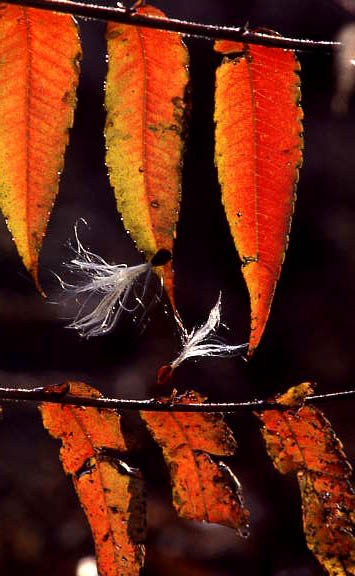
perilously by only one fiber each and swayed back and forth in the gentle
breeze
like two circus aerialists on trapezes. The sun was perfectly back lighting
the leaves and I simply made my composition and used a shutter speed of
250th to
freeze the swaying seeds. No reflectors or mirror were necessary on this
shot.
There were several other solitary seeds to be found and photographed.
One was entangled in a bush. The branches were mottled brown, but artistically

curved and the seed was nestled in an open spot. I chose a vertical camera
position,
and placed the radiating seed in the upper right portion of the composition
using
the “rule of thirds” here. The sun in this scenario was also
back lighting the seed
and bush for a dramatic final image.
Early one afternoon I found clusters of Purple Asters. Nestled amongst
the tiny flowers was a single seed still clinging to its silky parachute.
The scene
was nice and so I set up my tripod framed the scene and set up the reflector.
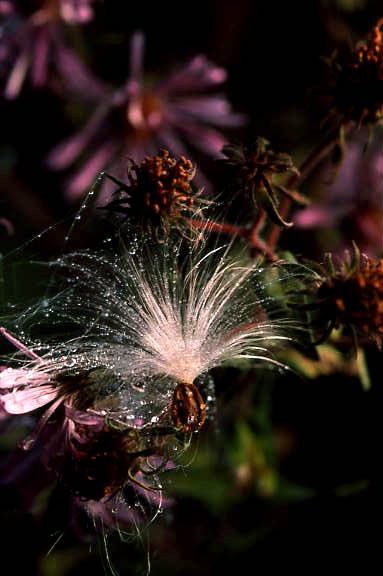
I began to take pictures and was about to “zoom” in on just
the tiny brown seed,
but before I could refocus the seed let go of the hairy fibers and dropped
amongst the dried grasses of the field. It had found its final destination.
Had it reached a
favorable place to germinate? As I walked slowly home I knew that question
could only be answered next spring.